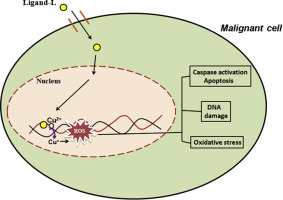Chemico-Biological Interactions ( IF 4.7 ) Pub Date : 2018-05-24 , DOI: 10.1016/j.cbi.2018.05.010 Saman Khan , Atif Zafar , Imrana Naseem

|
Coumarin is an important bioactive pharmacophore. It is found in plants as a secondary metabolite and exhibits diverse pharmacological properties including anticancer effects against different malignancies. Therapeutic efficacy of coumarin derivatives depends on the pattern of substitution and conjugation with different moieties. Cancer cells contain elevated copper as compared to normal cells that plays a role in angiogenesis. Thus, targeting copper in malignant cells via copper chelators can serve as an attractive targeted anticancer strategy. Our previous efforts led to the synthesis of di(2-picolyl)amine-3(bromoacetyl)coumarin hybrid molecule (ligand-L) endowed with DNA/Cu(II) binding properties, and ROS generation ability in the presence of copper ions. In the present study, we aimed to validate copper-dependent cytotoxic action of ligand-L against malignant cells. For this, we used a cellular model system of copper (Cu) overloaded lymphocytes (CuOLs) to simulate malignancy-like condition. In CuOLs, lipid peroxidation/protein carbonylation, ROS generation, DNA fragmentation and apoptosis were investigated in the presence of ligand-L. Results showed that ligand-L-Cu(II) interaction leads to ROS generation, lipid peroxidation/protein carbonylation (oxidative stress parameters), DNA damage, up-regulation of p53 and mitochondrial-mediated apoptosis in treated lymphocytes. Further, pre-incubation with neocuproine (membrane permeable copper chelator) and ROS scavengers attenuated the DNA damage and apoptosis. These results suggest that cellular copper acts as molecular target for ligand-L to propagate redox cycling and generation of ROS via Fenton-like reaction leading to DNA damage and apoptosis. Further, we showed that ligand-L targets elevated copper in breast cancer MCF-7 and colon cancer HCT116 cells leading to a pro-oxidant inhibition of proliferation of cancer cells. In conclusion, we propose copper-dependent ROS-mediated mechanism for the cytotoxic action of ligand-L in malignant cells. Thus, targeting elevated copper represents an effective therapeutic strategy for selective cytotoxicity against malignant cells.
中文翻译:

香豆素-二(2-吡啶甲基)胺杂合分子的铜-氧化还原循环导致ROS介导的DNA损伤和细胞凋亡:癌症化学预防的机制。
香豆素是重要的生物活性药效团。它在植物中被发现为次生代谢产物,并具有多种药理特性,包括针对不同恶性肿瘤的抗癌作用。香豆素衍生物的治疗功效取决于不同部分的取代和结合方式。与在血管生成中起作用的正常细胞相比,癌细胞中铜含量升高。因此,通过铜螯合剂靶向恶性细胞中的铜可以作为有吸引力的靶向抗癌策略。我们先前的努力导致了具有DNA / Cu(II)结合特性和在铜离子存在下的ROS生成能力的二(2-吡啶甲基)胺-3(溴乙酰基)香豆素杂合分子(ligand-L)的合成。在目前的研究中,我们旨在验证配体L对恶性细胞的铜依赖性细胞毒作用。为此,我们使用了铜(Cu)超负荷淋巴细胞(CuOLs)的细胞模型系统来模拟恶性肿瘤。在CuOLs中,在存在配体L的情况下研究了脂质过氧化/蛋白质羰基化,ROS生成,DNA片段化和凋亡。结果表明,配体-L-Cu(II)相互作用导致ROS生成,脂质过氧化/蛋白质羰基化(氧化应激参数),DNA损伤,p53的上调和线粒体介导的细胞凋亡。此外,与新铜环丙氨酸(膜可渗透的铜螯合剂)和ROS清除剂一起预孵育可减弱DNA损伤和细胞凋亡。这些结果表明细胞铜充当配体-L的分子靶标,以通过Fenton样反应传播氧化还原循环和ROS的产生,从而导致DNA损伤和细胞凋亡。此外,我们显示,配体L靶向乳腺癌MCF-7和结肠癌HCT116细胞中升高的铜,从而导致癌细胞增殖的促氧化剂抑制作用。总之,我们提出了铜依赖性ROS介导的对配体-L在恶性细胞中的细胞毒性作用的机制。因此,靶向升高的铜代表针对恶性细胞的选择性细胞毒性的有效治疗策略。我们显示,配体L靶向乳腺癌MCF-7和结肠癌HCT116细胞中升高的铜,导致促氧化剂抑制癌细胞的增殖。总之,我们提出了铜依赖的ROS介导的配体L在恶性细胞中的细胞毒性作用的机制。因此,靶向升高的铜代表针对恶性细胞的选择性细胞毒性的有效治疗策略。我们显示,配体L靶向乳腺癌MCF-7和结肠癌HCT116细胞中升高的铜,导致促氧化剂抑制癌细胞的增殖。总之,我们提出了铜依赖性ROS介导的对配体-L在恶性细胞中的细胞毒性作用的机制。因此,靶向升高的铜代表针对恶性细胞的选择性细胞毒性的有效治疗策略。











































 京公网安备 11010802027423号
京公网安备 11010802027423号